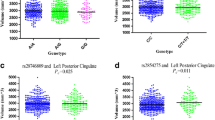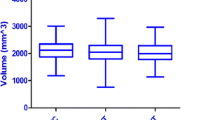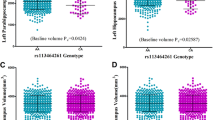Abstract
There is accumulating evidence that the human leukocyte antigen (HLA) gene variants are associated with Alzheimer’s disease (AD). However, how they affect AD occurrence is still unknown. In this study, we firstly investigated the association of gene variants in HLA gene variants and brain structures on MRI in a large sample from the Alzheimer’s Disease Neuroimaging Initiative (ADNI) to explore the effects of HLA on AD pathogenesis. We selected hippocampus, hippocampus CA1 subregion, parahippocampus, posterior cingulate, precuneus, middle temporal, entorhinal cortex, and amygdala as regions of interest (ROIs). According to the previous association studies of HLA variants and AD, 12 SNPs in HLA were identified in the dataset following quality control measures. In total group analysis, our results showed that TNF-α SNPs at rs2534672 and rs2395488 were significantly positively associated with the volume of the left middle temporal lobe (rs2534672: P = 0.00035, Pc = 0.004; rs2395488: P = 0.0038, Pc = 0.023) at baseline. In the longitudinal study, HFE rs1800562 was remarkably correlated with the lower atrophy rate of right middle temporal lobe (P = 0.0003, Pc = 0.003) and RAGE rs2070600 was associated with the atrophy rate of right hippocampus substructure-CA1 over 2 years (P = 0.003, Pc = 0.035). Furthermore, we detected the above four associations in mild cognitive impairment (MCI) subgroup analysis, as well as the association of rs2534672 with the baseline volume of the left middle temporal lobe in normal cognition (NC) subgroup analysis. Our study provided preliminary evidences that HLA gene variants might participate in the structural alteration of AD associated brain regions, hence modulating the susceptibility of AD.


Similar content being viewed by others
References
Gatz M, Reynolds CA, Fratiglioni L, Johansson B, Mortimer JA, Berg S, Fiske A, Pedersen NL (2006) Role of genes and environments for explaining Alzheimer disease. Arch Gen Psychiatry 63(2):168–174. doi:10.1001/archpsyc.63.2.168
Tan MS, Jiang T, Tan L, Yu JT (2014) Genome-wide association studies in neurology. Ann Transl Med 2(12):124. doi:10.3978/j.issn.2305-5839.2014.11.12
Licastro F, Candore G, Lio D, Porcellini E, Colonna-Romano G, Franceschi C, Caruso C (2005) Innate immunity and inflammation in ageing: a key for understanding age-related diseases. Immun Ageing 2:8. doi:10.1186/1742-4933-2-8
Jiang T, Yu JT, Tian Y, Tan L (2013) Epidemiology and etiology of Alzheimer’s disease: from genetic to non-genetic factors. Curr Alzheimer Res 10(8):852–867
Candore G, Balistreri CR, Colonna-Romano G, Lio D, Caruso C (2004) Major histocompatibility complex and sporadic Alzheimer’s disease: a critical reappraisal. Exp Gerontol 39(4):645–652. doi:10.1016/j.exger.2003.10.027
Heppner FL, Ransohoff RM, Becher B (2015) Immune attack: the role of inflammation in Alzheimer disease. Nat Rev Neurosci 16(6):358–372. doi:10.1038/nrn3880
Mawanda F, Wallace R (2013) Can infections cause Alzheimer’s disease? Epidemiol Rev 35:161–180. doi:10.1093/epirev/mxs007
Xia Z, Chibnik LB, Glanz BI, Liguori M, Shulman JM, Tran D, Khoury SJ, Chitnis T et al (2010) A putative Alzheimer’s disease risk allele in PCK1 influences brain atrophy in multiple sclerosis. PLoS One 5(11):e14169. doi:10.1371/journal.pone.0014169
Connor JR, Lee SY (2006) HFE mutations and Alzheimer’s disease. J Alzheimers Dis 10(2–3):267–276
Lin M, Zhao L, Fan J, Lian XG, Ye JX, Wu L, Lin H (2012) Association between HFE polymorphisms and susceptibility to Alzheimer’s disease: a meta-analysis of 22 studies including 4,365 cases and 8,652 controls. Mol Biol Rep 39(3):3089–3095. doi:10.1007/s11033-011-1072-z
Robson KJ, Lehmann DJ, Wimhurst VL, Livesey KJ, Combrinck M, Merryweather-Clarke AT, Warden DR, Smith AD (2004) Synergy between the C2 allele of transferrin and the C282Y allele of the haemochromatosis gene (HFE) as risk factors for developing Alzheimer’s disease. J Med Genet 41(4):261–265
Lambert JC, Ibrahim-Verbaas CA, Harold D, Naj AC, Sims R, Bellenguez C, DeStafano AL, Bis JC et al (2013) Meta-analysis of 74,046 individuals identifies 11 new susceptibility loci for Alzheimer’s disease. Nat Genet 45(12):1452–1458. doi:10.1038/ng.2802
Bullido MJ, Martinez-Garcia A, Artiga MJ, Aldudo J, Sastre I, Gil P, Coria F, Munoz DG et al (2007) A TAP2 genotype associated with Alzheimer’s disease in APOE4 carriers. Neurobiol Aging 28(4):519–523. doi:10.1016/j.neurobiolaging.2006.02.011
Moreno-Grau S, Barneda B, Carriba P, Marin J, Sotolongo-Grau O, Hernandez I, Rosende-Roca M, Mauleon A et al (2015) Evaluation of candidate genes related to neuronal apoptosis in Late-Onset Alzheimer’s disease. J Alzheimers Dis 45(2):621–629. doi:10.3233/JAD-142721
Culpan D, MacGowan SH, Ford JM, Nicoll JA, Griffin WS, Dewar D, Cairns NJ, Hughes A et al (2003) Tumour necrosis factor-alpha gene polymorphisms and Alzheimer’s disease. Neurosci Lett 350(1):61–65
Maggioli E, Boiocchi C, Zorzetto M, Sinforiani E, Cereda C, Ricevuti G, Cuccia M (2013) The human leukocyte antigen class III haplotype approach: new insight in Alzheimer’s disease inflammation hypothesis. Curr Alzheimer Res 10(10):1047–1056
Li K, Dai D, Zhao B, Yao L, Yao S, Wang B, Yang Z (2010) Association between the RAGE G82S polymorphism and Alzheimer’s disease. J Neural Transm 117(1):97–104. doi:10.1007/s00702-009-0334-6
Stern Y (2012) Cognitive reserve in ageing and Alzheimer’s disease. Lancet Neurol 11(11):1006–1012. doi:10.1016/S1474-4422(12)70191-6
Xu W, Yu JT, Tan MS, Tan L (2015) Cognitive reserve and Alzheimer’s disease. Mol Neurobiol 51(1):187–208. doi:10.1007/s12035-014-8720-y
Simmons A, Westman E, Muehlboeck S, Mecocci P, Vellas B, Tsolaki M, Kloszewska I, Wahlund LO et al (2009) MRI measures of Alzheimer’s disease and the AddNeuroMed study. Ann N Y Acad Sci 1180:47–55. doi:10.1111/j.1749-6632.2009.05063.x
Desikan RS, Cabral HJ, Fischl B, Guttmann CR, Blacker D, Hyman BT, Albert MS, Killiany RJ (2009) Temporoparietal MR imaging measures of atrophy in subjects with mild cognitive impairment that predict subsequent diagnosis of Alzheimer disease. AJNR Am J Neuroradiol 30(3):532–538. doi:10.3174/ajnr.A1397
Hill D (2010) Neuroimaging to assess safety and efficacy of AD therapies. Expert Opin Investig Drugs 19(1):23–26. doi:10.1517/13543780903381320
Peper JS, Brouwer RM, Boomsma DI, Kahn RS, Hulshoff Pol HE (2007) Genetic influences on human brain structure: a review of brain imaging studies in twins. Hum Brain Mapp 28(6):464–473. doi:10.1002/hbm.20398
Zhang X, Yu JT, Li J, Wang C, Tan L, Liu B, Jiang T (2015) Bridging integrator 1 (BIN1) genotype effects on working memory, hippocampal volume, and functional connectivity in young healthy individuals. Neuropsychopharmacol: Off Publ Am Coll Neuropsychopharmacol 40(7):1794–1803. doi:10.1038/npp.2015.30
Mueller SG, Weiner MW, Thal LJ, Petersen RC, Jack C, Jagust W, Trojanowski JQ, Toga AW et al (2005) The Alzheimer’s disease neuroimaging initiative. Neuroimaging Clin N Am 15(4):869–877. doi:10.1016/j.nic.2005.09.008, xi-xii
Petersen RC, Aisen PS, Beckett LA, Donohue MC, Gamst AC, Harvey DJ, Jack CR Jr, Jagust WJ et al (2010) Alzheimer’s disease neuroimaging initiative (ADNI): clinical characterization. Neurology 74(3):201–209. doi:10.1212/WNL.0b013e3181cb3e25
Desikan RS, Segonne F, Fischl B, Quinn BT, Dickerson BC, Blacker D, Buckner RL, Dale AM et al (2006) An automated labeling system for subdividing the human cerebral cortex on MRI scans into gyral based regions of interest. NeuroImage 31(3):968–980. doi:10.1016/j.neuroimage.2006.01.021
Reuter M, Rosas HD, Fischl B (2010) Highly accurate inverse consistent registration: a robust approach. NeuroImage 53(4):1181–1196. doi:10.1016/j.neuroimage.2010.07.020
Segonne F, Dale AM, Busa E, Glessner M, Salat D, Hahn HK, Fischl B (2004) A hybrid approach to the skull stripping problem in MRI. NeuroImage 22(3):1060–1075. doi:10.1016/j.neuroimage.2004.03.032
Fischl B, Salat DH, Busa E, Albert M, Dieterich M, Haselgrove C, van der Kouwe A, Killiany R et al (2002) Whole brain segmentation: automated labeling of neuroanatomical structures in the human brain. Neuron 33(3):341–355
Fischl B, Salat DH, van der Kouwe AJ, Makris N, Segonne F, Quinn BT, Dale AM (2004) Sequence-independent segmentation of magnetic resonance images. Neuro Image 23(Suppl 1):S69–84. doi:10.1016/j.neuroimage.2004.07.016
Sled JG, Zijdenbos AP, Evans AC (1998) A nonparametric method for automatic correction of intensity nonuniformity in MRI data. IEEE Trans Med Imaging 17(1):87–97. doi:10.1109/42.668698
Segonne F, Pacheco J, Fischl B (2007) Geometrically accurate topology-correction of cortical surfaces using nonseparating loops. IEEE Trans Med Imaging 26(4):518–529. doi:10.1109/TMI.2006.887364
Fischl B, Liu A, Dale AM (2001) Automated manifold surgery: constructing geometrically accurate and topologically correct models of the human cerebral cortex. IEEE Trans Med Imaging 20(1):70–80. doi:10.1109/42.906426
Jack CR Jr, Albert MS, Knopman DS, McKhann GM, Sperling RA, Carrillo MC, Thies B, Phelps CH (2011) Introduction to the recommendations from the National Institute on Aging-Alzheimer’s Association workgroups on diagnostic guidelines for Alzheimer’s disease. Alzheimers Dementia: J Alzheimers Assoc 7(3):257–262. doi:10.1016/j.jalz.2011.03.004
Schroder J, Pantel J (2016) Neuroimaging of hippocampal atrophy in early recognition of Alzheimer s disease - a critical appraisal after two decades of research. Psychiatry Res 247:71–78. doi:10.1016/j.pscychresns.2015.08.014
Nesteruk M, Nesteruk T, Styczynska M, Barczak A, Mandecka M, Walecki J, Barcikowska-Kotowicz M (2015) Predicting the conversion of mild cognitive impairment to Alzheimer’s disease based on the volumetric measurements of the selected brain structures in magnetic resonance imaging. Neurol Neurochir Pol 49(6):349–353. doi:10.1016/j.pjnns.2015.09.003
Lin TW, Liu YF, Shih YH, Chen SJ, Huang TY, Chang CY, Lien CH, Yu L et al (2015) Neurodegeneration in Amygdala Precedes Hippocampus in the APPswe/PS1dE9 mouse model of Alzheimer’s disease. Curr Alzheimer Res 12(10):951–963
Yin RH, Tan L, Liu Y, Wang WY, Wang HF, Jiang T, Zhang Y, Gao J et al (2015) Multimodal voxel-based meta-analysis of white matter abnormalities in Alzheimer’s disease. J Alzheimers Dis 47(2):495–507. doi:10.3233/JAD-150139
Wang WY, Yu JT, Liu Y, Yin RH, Wang HF, Wang J, Tan L, Radua J et al (2015) Voxel-based meta-analysis of grey matter changes in Alzheimer’s disease. Transl Neurodegener 4:6. doi:10.1186/s40035-015-0027-z
Braak H, Braak E (1996) Evolution of the neuropathology of Alzheimer’s disease. Acta Neurol Scand Suppl 165:3–12
Eustache P, Nemmi F, Saint-Aubert L, Pariente J, Peran P (2016) Multimodal magnetic resonance imaging in Alzheimer’s disease patients at prodromal stage. J Alzheimers Dis 50(4):1035–1050. doi:10.3233/JAD-150353
Simic G, Babic M, Borovecki F, Hof PR (2014) Early failure of the default-mode network and the pathogenesis of Alzheimer’s disease. CNS Neurosci Ther 20(7):692–698. doi:10.1111/cns.12260
Biffi A, Anderson CD, Desikan RS, Sabuncu M, Cortellini L, Schmansky N, Salat D, Rosand J et al (2010) Genetic variation and neuroimaging measures in Alzheimer disease. Arch Neurol 67(6):677–685. doi:10.1001/archneurol.2010.108
Hochberg Y, Benjamini Y (1990) More powerful procedures for multiple significance testing. Stat Med 9(7):811–818
Heneka MT, Carson MJ, El Khoury J, Landreth GE, Brosseron F, Feinstein DL, Jacobs AH, Wyss-Coray T et al (2015) Neuroinflammation in Alzheimer’s disease. Lancet Neurol 14(4):388–405. doi:10.1016/S1474-4422(15)70016-5
Tchelingerian JL, Vignais L, Jacque C (1994) TNF alpha gene expression is induced in neurones after a hippocampal lesion. Neuroreport 5(5):585–588
Viviani B, Corsini E, Galli CL, Marinovich M (1998) Glia increase degeneration of hippocampal neurons through release of tumor necrosis factor-alpha. Toxicol Appl Pharmacol 150(2):271–276. doi:10.1006/taap.1998.8406
Risacher SL, Saykin AJ, West JD, Shen L, Firpi HA, McDonald BC, Alzheimer’s Disease Neuroimaging I (2009) Baseline MRI predictors of conversion from MCI to probable AD in the ADNI cohort. Curr Alzheimer Res 6(4):347–361
Simon M, Bourel M, Fauchet R, Genetet B (1976) Association of HLA-A3 and HLA-B14 antigens with idiopathic haemochromatosis. Gut 17(5):332–334
Ali-Rahmani F, Schengrund CL, Connor JR (2014) HFE gene variants, iron, and lipids: a novel connection in Alzheimer’s disease. Front Pharmacol 5:165. doi:10.3389/fphar.2014.00165
Nandar W, Connor JR (2011) HFE gene variants affect iron in the brain. J Nutr 141(4):729S–739S. doi:10.3945/jn.110.130351
Jahanshad N, Kohannim O, Hibar DP, Stein JL, McMahon KL, de Zubicaray GI, Medland SE, Montgomery GW et al (2012) Brain structure in healthy adults is related to serum transferrin and the H63D polymorphism in the HFE gene. Proc Natl Acad Sci U S A 109(14):E851–859. doi:10.1073/pnas.1105543109
Guerreiro RJ, Bras JM, Santana I, Januario C, Santiago B, Morgadinho AS, Ribeiro MH, Hardy J et al (2006) Association of HFE common mutations with Parkinson’s disease, Alzheimer’s disease and mild cognitive impairment in a Portuguese cohort. BMC Neurol 6:24. doi:10.1186/1471-2377-6-24
Candore G, Licastro F, Chiappelli M, Franceschi C, Lio D, Rita Balistreri C, Piazza G, Colonna-Romano G et al (2003) Association between the HFE mutations and unsuccessful ageing: a study in Alzheimer’s disease patients from Northern Italy. Mech Ageing Dev 124(4):525–528
Berlin D, Chong G, Chertkow H, Bergman H, Phillips NA, Schipper HM (2004) Evaluation of HFE (hemochromatosis) mutations as genetic modifiers in sporadic AD and MCI. Neurobiol Aging 25(4):465–474. doi:10.1016/j.neurobiolaging.2003.06.008
Sampietro M, Caputo L, Casatta A, Meregalli M, Pellagatti A, Tagliabue J, Annoni G, Vergani C (2001) The hemochromatosis gene affects the age of onset of sporadic Alzheimer’s disease. Neurobiol Aging 22(4):563–568
Lehmann DJ, Schuur M, Warden DR, Hammond N, Belbin O, Kolsch H, Lehmann MG, Wilcock GK et al (2012) Transferrin and HFE genes interact in Alzheimer’s disease risk: the Epistasis Project. Neurobiol Aging 33(1):202 e201–213. doi:10.1016/j.neurobiolaging.2010.07.018
Cai Z, Liu N, Wang C, Qin B, Zhou Y, Xiao M, Chang L, Yan LJ et al (2015) Role of RAGE in Alzheimer’s disease. Cell Mol Neurobiol. doi:10.1007/s10571-015-0233-3
Deane R, Zlokovic BV (2007) Role of the blood–brain barrier in the pathogenesis of Alzheimer’s disease. Curr Alzheimer Res 4(2):191–197
Piras S, Furfaro AL, Piccini A, Passalacqua M, Borghi R, Carminati E, Parodi A, Colombo L et al (2014) Monomeric Abeta1-42 and RAGE: key players in neuronal differentiation. Neurobiol Aging 35(6):1301–1308. doi:10.1016/j.neurobiolaging.2014.01.002
Kuhla A, Ludwig SC, Kuhla B, Munch G, Vollmar B (2015) Advanced glycation end products are mitogenic signals and trigger cell cycle reentry of neurons in Alzheimer’s disease brain. Neurobiol Aging 36(2):753–761. doi:10.1016/j.neurobiolaging.2014.09.025
Daborg J, von Otter M, Sjolander A, Nilsson S, Minthon L, Gustafson DR, Skoog I, Blennow K et al (2010) Association of the RAGE G82S polymorphism with Alzheimer’s disease. J Neural Transm 117(7):861–867. doi:10.1007/s00702-010-0437-0
Cabeza R, Nyberg L (2000) Neural bases of learning and memory: functional neuroimaging evidence. Curr Opin Neurol 13(4):415–421
Braak H, Braak E (1991) Neuropathological stageing of Alzheimer-related changes. Acta Neuropathol 82(4):239–259
Dickerson BC, Goncharova I, Sullivan MP, Forchetti C, Wilson RS, Bennett DA, Beckett LA, deToledo-Morrell L (2001) MRI-derived entorhinal and hippocampal atrophy in incipient and very mild Alzheimer’s disease. Neurobiol Aging 22(5):747–754
Pennanen C, Kivipelto M, Tuomainen S, Hartikainen P, Hanninen T, Laakso MP, Hallikainen M, Vanhanen M et al (2004) Hippocampus and entorhinal cortex in mild cognitive impairment and early AD. Neurobiol Aging 25(3):303–310. doi:10.1016/S0197-4580(03)00084-8
Acknowledgments
Data collection and sharing were funded by ADNI (National Institutes of Health U01 AG024904). ADNI is funded by the National Institute on Aging, the National Institute of Biomedical Imaging and Bioengineering, the Alzheimer’s Association, the Alzheimer’s Drug Discovery Foundation, BioClinica, Inc., Biogen Idec Inc., Bristol-Myers Squibb Co, F. Hoffmann-LaRoche Ltd and Genetech, Inc., GE Healthcare, Innogenetics, NV, IXICO Ltd, Janssen Alzheimer Immunotherapy Research & Development LLC, Medpace, Inc., Merck & Co, Inc., Meso Scale Diagnostics, LLC, NeuroRx Research, Novartis Pharmaceuticals, Co, Pfizer, Inc., Piramal Imaging, Servier, Synarc Inc., and Takeda Pharmaceutical Co. The Canadian Institutes of Health Research is providing funds to support ADNI clinical sites in Canada. Private sector contributions are facilitated by the Foundation for the National Institutes of Health (www.fnih.org). The grantee organization was the Northern California Institute for Research and Education, and the study was coordinated by the Alzheimer’s Disease Cooperative Study at the University of California, San Diego. ADNI data are disseminated by the Laboratory for Neuro Imaging at the University of California, Los Angeles.
This work was also supported by grants from the National Natural Science Foundation of China (81471309, 81171209, 81371406, 81501103, and 81571245), the Shandong Provincial Outstanding Medical Academic Professional Program, Qingdao Key Health Discipline Development Fund, Qingdao Outstanding Health Professional Development Fund, and Shandong Provincial Collaborative Innovation Center for Neurodegenerative Disorders.
Author information
Authors and Affiliations
Consortia
Corresponding authors
Ethics declarations
Conflict of Interest
All of the authors declare no conflict of interests.
Additional information
Data used in preparation of this article were obtained from the Alzheimer’s Disease Neuroimaging Initiative (ADNI) database (adni.loni.usc.edu). As such, the investigators within the ADNI contributed to the design and implementation of ADNI and/or provided data but did not participate in analysis or writing of this report. A complete listing of ADNI investigators can be found at http://adni.loni.usc.edu/wp-content/uploads/how_to_apply/ADNI_Acknowledgement_List.pdf
Zi-Xuan Wang and Yu Wan contributed equally to this work.
Rights and permissions
About this article
Cite this article
Wang, ZX., Wan, Y., Tan, L. et al. Genetic Association of HLA Gene Variants with MRI Brain Structure in Alzheimer’s Disease. Mol Neurobiol 54, 3195–3204 (2017). https://doi.org/10.1007/s12035-016-9889-z
Received:
Accepted:
Published:
Issue Date:
DOI: https://doi.org/10.1007/s12035-016-9889-z




